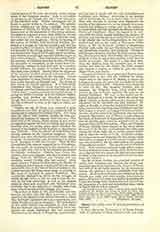

Clouet, the family name of several generations of painters.
I. JEAN (JEAN THE YOUNGER), b. at Tours, France, 1485; d., probably at Paris, between 1541 and 1545. He was the son and pupil of Jean the Elder, a Flemish painter who went to Paris from Brussels in 1460 and afterwards settled at Tours. Francis I made the son court painter at Paris, and, in 1518, a valet de chambre, a post of distinction. The court called him familiarly “Janet”, a name which became generic, comprising his father, his son Francois, and their numerous imitators. Ronsard sang:
Peins moy, Janet, peins moy je t’en supplie.
His numerous portraits of royalty and nobility are all in the antique, or Gothic, style, like that of the Van Eycks. His outlines are sharp and precise, all the lines are clear, and he gives great attention to details. Clouet painted his sitter with fidelity and avoided theatrical (Italian) effects; hence the result is a portrait, simple, reticent, and naive. Much of his work was until recently attributed to Holbein. In 1524 he painted the celebrated portrait of Francis I in full armor on horseback, and in 1528 another, a life-size bust (now at Versailles), long ascribed to Mabuse. Some authorities claim that of his many pictures only one is authentic: the portrait of Francis I in the Louvre. Other notable works of Clouet’s are “Elea-nor of Spain” (wife of Francis I) in Hampton Court, and “Margaret of Valois” in Liverpool.
II. FRANCOIS, called FRANCOIS JANET and MAITRE JEHANNET, b. probably at Tours, between 1500 and 1520; d. at Paris, between 1570 and 1580. He was the son and pupil of Jean the Younger and was naturalized in 1541. At the age of thirty-five he succeeded his father as court painter to Francis I, to whom he was also appointed a valet de chambre. Francois was also court painter to Charles IX, at the close of whose reign all traces of him disappear. Clouet’s work in oil, while Flemish in its scrupulous attention to details, is, however, distinctively French, and he carried to its highest the fame of “the Janets”. He was the last of the French primiti f s. His pictures are painted solidly, in pale, delicate tones, and without chiaroscuro. Clouet’s portraits are true, accurate, and devoid of sentimentality; they show forth the moral and intellectual qualities of each sitter; and they “have the charm of intime painting” (Blanc). Two portraits of great brilliancy and distinction are the “Francis II as a Child” (1547) now at Antwerp, and “Henry II” (1553) in the Louvre; but Berlin possesses what are, perhaps, his masterpieces: “Francis II” and the “Duc d’Anjou” (Henry III). Clouet’s office required him to depict every great court function, and as late as 1709 such a group of pictures was in existence. He made many sketches in black and red chalk, showing perfect draughtsmanship and splendid modeling. Castle Howard contains eighty-eight such drawings, all in the manner of Holbein. Clouet also painted miniatures; that of greatest historical interest is “Mary Queen of Scots” (Windsor Castle), which has never been out of royal possession since catalogued, in the time of Charles, as “by Jennet a French limner”. It is probably the only authentic picture of the unhappy Mary. Clouet’s work was highly valued during his lifetime, and he was a power at the courts of Francis I, Henry II, Francis II, and Charles IX. The brilliant men and women about these monarchs felt that “the Janets” had elevated art and France. Today their pictures are so highly prized that many forgeries are made of them. Besides those mentioned, other great canvases by Francois are “Elizabeth of Austria”, “Charles IX”, both in the Louvre, and four portraits in Stafford House (London). Collections of his drawings are in the Louvre, British Museum, and Albertina Museum (Vienna).
LEIGH HUNT

